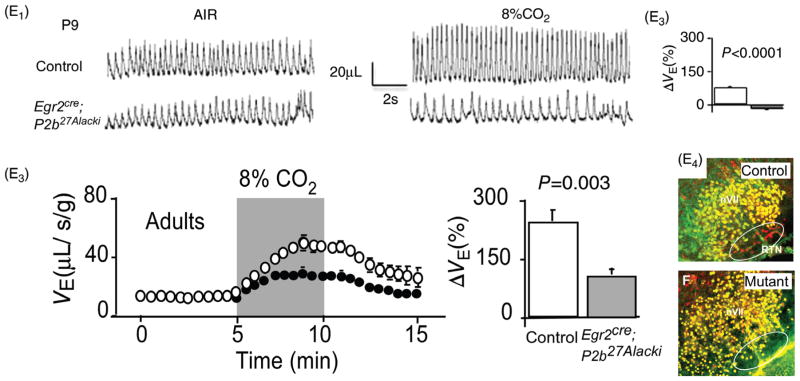Figure 4.
Gain and loss of function of RTN Phox2b neurons in conscious rodents: effect on breathing and the hypercapnic ventilatory reflex (HCVR). (A) Steady-state ventilatory response of a conscious rat exposed to graded levels of hypercapnia. Breathing was measured by whole body plethysmography [reprinted from (236) with permission from Elsevier]. Note that, at 8% FiCO2, fR (respiratory rate) doubles and VE triples. (B) Unilateral acidification of the RTN with a dialysis probe containing a fluid equilibrated with 25% CO2 produces a small (24% average) increase in VE [adapted from Li et al. J. Appl. Physiol. (240) with permission]. (C) Unilateral optogenetic activation (20Hz) of around 35% of RTN Phox2b neurons triples VE in a conscious rat [adapted, with permission, from (4)]. (C1) Typical example (plethysmography); (C2-C4) average responses (from top to bottom: frequency, tidal volume and minute volume) to unilateral optogenetic stimulation of RTN neurons. (C5) Selective expression of ChR2-mCherry fusion protein by RTN (i.e., Phox2b+) neurons in one such animal (Phox2b in green; mCherry in red). (D1) Attenuation of the hypercapnic ventilatory reflex by i.c.v. allatostatin administration to a conscious rat in which an unknown fraction of RTN neurons were transduced with the allatostatin receptor. (D2) Average results from five rats [(from Marina et al. (269) with permission]. (E1) Absence of HCVR in neonatal (day 9) transgenic mice in which a mutated form of transcription factor Phox2b (Phox2b-27ala) is expressed selectively by cells of rhombomere 3 and 5 lineage (Phox2b27Alacki; Egr2cre/0) preventing or aborting RTN neuron development. (E2) Group data. (E3) Partial recovery (one third) of the HCVR in adult Phox2b27Alacki; Egr2cre/0 mice. (E4) Absence of Phox2b-ir neurons in the RTN of a Phox2b27Alacki; Egr2cre/0 mouse (embryonic day 14; RTN identified by white oval, Phox2b in red) [E1–E4 reprinted from Ramanantsoa et al. (346) with permission].


